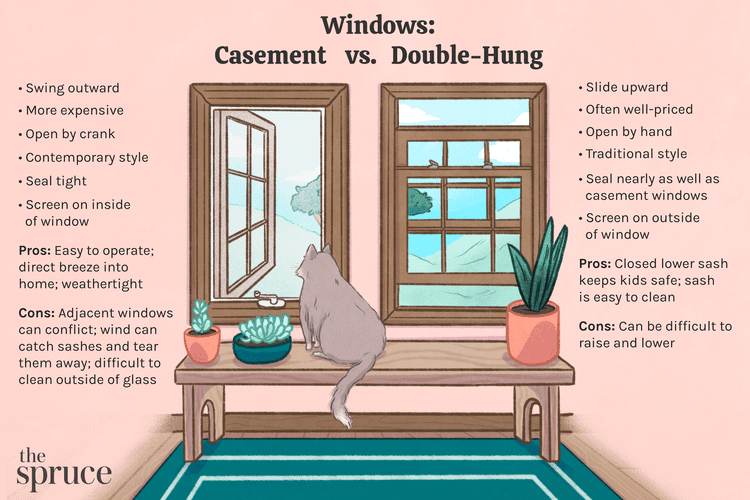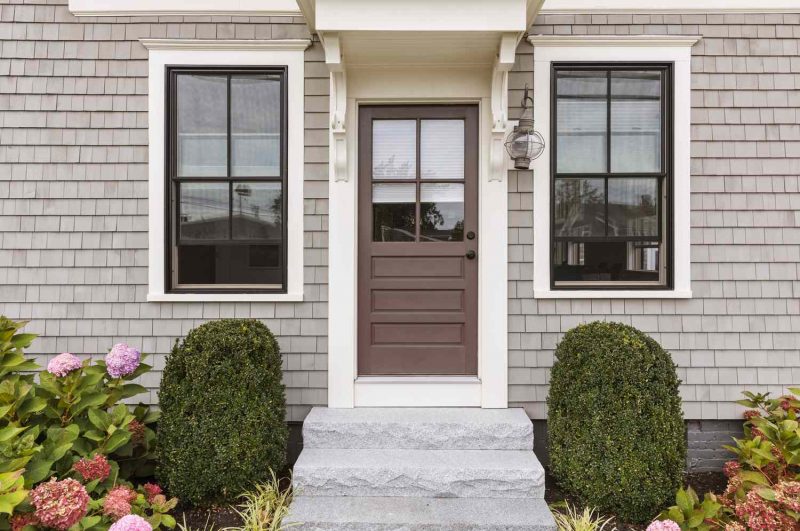
When looking for replacement or new-construction windows, it’s important to evaluate two specific styles: casement windows and double-hung windows. While they share some common features, they serve distinct purposes and are suited for different applications.
By evaluating aspects such as design options, energy efficiency, operating systems, expenses, and longevity, you will notice distinct contrasts between the two window types, making your decision straightforward.
Contents
Casement and Double-Hung Windows: Key Distinctions
The primary distinction between casement and double-hung windows lies in their operation. Casement windows are attached with hinges on one side, allowing them to swing open and shut horizontally, similar to a door. In contrast, double-hung windows operate by moving their sashes vertically, sliding them up and down.
Another distinction lies in their method of operation. Casement windows are controlled by a hand-operated crank located inside the home. By turning the crank, a gearbox is activated, which either opens or closes the window.
Double-hung windows feature two sashes, one on top and one on the bottom, that move vertically. To operate them, the user grips a handle and raises or lowers one of the sashes.

| Casement Windows Compared to Double-Hung Windows | ||
|---|---|---|
| Casement Windows | Double-Hung Windows | |
| Style | Swings like a door | Slides up and down vertically |
| Cost | More expensive | Lower priced |
| Opening | Crank | Lift by hand |
| Style | Contemporary, clean | Traditional, classic |
| Issues | Crank failure | Sash balancing unit |
| Screen | Inside of window | Outside of window |
Casement-style windows
- Simple to open and shut.
- Beneficial for users with disabilities
- Air can be channeled within a house.
- Crank malfunction
- Unable to accommodate air conditioning units.
- The window can detach the sash.
Casement windows offer a simple mechanism for opening and closing. Using a crank and a lever for locking is more convenient than the traditional method of sliding a sash vertically.
For this reason alone, casement windows are a superior option compared to double-hung windows for individuals with disabilities or those who have restricted mobility.
Casement windows can be opened and closed from a seated position in a wheelchair, although help might be required to manage the latch.
Tip
Strategically placed casement windows allow the open sashes to function as channels, enhancing the flow of outdoor breezes and directing fresh air into the interior of the house.
Standard window unit air conditioners are incompatible with casement and sliding windows, necessitating the use of more costly specialized air conditioning units. Additionally, strong gusts of wind can seize a casement sash and potentially tear it off.
Inadequately positioned casement windows can lead to issues with overlapping sashes. For instance, if two casement windows are situated at an interior corner, their sashes may clash. Additionally, a flawed design can occur when two adjacent casement windows open in opposite directions, forming a closed space that obstructs airflow.
One drawback of the cranking mechanism is that it may take a considerable amount of time to simultaneously open and close a significant number of casement windows.
Sash Windows
- Extensive variety
- Minimal rate of failure
- Secure the lower sash while keeping the upper sash open.
- Harder to operate for opening and closing.
- A spring scale might not function properly.
- The sash frame obstructs the view.
Double-hung windows come equipped with a safety mechanism designed for children and pets, allowing the lower sash to be closed while the upper sash remains open. These windows are dependable and exhibit a low incidence of malfunction.
While many modern double-hung windows feature sashes that swing inward, they remain more challenging to clean on the exterior compared to casement windows.
When you can easily reach it, a double-hung window is quite simple to use. A spring mechanism assists in raising the window, while gravity facilitates its closure. However, if you need to reach out to access the window, it can become quite challenging to operate.
Latching
- Casement windows require an interior latch to be engaged for complete security when closed. The sash of a casement window opens outward, facing the outside of the house.
- Double-hung windows typically feature an upper sash that stays fixed while the lower sash moves vertically. Nevertheless, the upper sash is also capable of sliding up and down. Both sashes can secure themselves in the center of the window.
Cost
- Casement windows typically come at a higher price point compared to double-hung windows, often costing double. This price difference is largely due to the intricate mechanical workings of casement windows, along with a reduced demand from consumers.
- Double-hung windows typically come at a lower price point compared to casement windows. The intense competition among window producers contributes to keeping the prices of this favored window style in check.
Styles
- Casement windows offer a modern aesthetic. Their straightforward design and sleek lines make them a perfect fit for contemporary homes.
- Double-hung windows embody a timeless and classic aesthetic. They complement vintage cottage-style homes beautifully and are also a great fit for modern houses designed to reflect a more traditional appearance.
Mechanical Problems
- Casement windows often experience issues with their crank mechanism, which tends to be the first component to malfunction. Even in the absence of a sudden breakdown, these windows can gradually become less secure, leading to increased air infiltration in your home.
- Double-hung windows tend to experience fewer issues compared to casement windows, primarily due to having fewer mechanical components that could malfunction. However, one common issue with double-hung windows is the occurrence of dropped sashes, where the lower sash fails to remain in the raised position.
Energy
- Casement windows are highly effective at minimizing air leakage in your home. The window sash fits snugly against all four sides of the frame and its seals, similar to how an exterior door fits within its frame. When the window is latched, the sash is drawn even tighter against the seals.
- Double-hung windows feature a design where the lower section and the two vertical edges are securely positioned within the side tracks. The only area where air might leak is at the top, although effective sealing can help minimize this issue.

